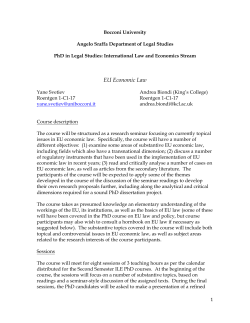
Syllabus
dr Marcin Kolasa marcin.kolasa@sgh.waw.pl akson.sgh.waw.pl/~mkolas/ dr Krzysztof Makarski krzysztof.makarski@sgh.waw.pl akson.sgh.waw.pl/~kmakar/ Macroeconomic Modelling 1. Introduction: trend vs. cycle, data filtering. Readings: Canova (2007): 1, 3. 2. Simple algorithms to solve dynamic models. Readings: Judd (1998): 10. 3. Overlapping generations models. Readings: Auerbach and Kotlikoff (1987): 3-4. 4. Recursive deterministic models. Value function iteration. Readings: McCandless (2008): 4; Heer and Maussner (2008): 1. 5. Recursive stochastic models. Tauchen method. Readings: McCandless (2008): 5; Heer and Maussner (2008): 1. 6. Bewley models. Readings: Ljungqvist and Sargent (2005): 17; Heer and Maussner (2008): 7; Aiyagari (1994). 7. Perturbation methods. Readings: Canova (2007): 2; Judd (1998): 13-14; McCandless (2008): 6; Heer and Maussner (2008): 2. 8. Estimation of dynamic stochastic models. Readings: Canova (2007): 5-6, 9; Barillas, Bhandari, Colacito, Kitao, Matthes, Sargent, and Shin (2010). Evaluation is based on classroom activity, i.e. attending the classes and solving the problems given by the instructor during the classes. Additionally, students can prepare a mini-research project that will apply or extend the methods studied during the course. The aim of the course is to make students familiar with the most popular methods used in contemporary macroeconomic analysis. The main emphasis will be on dynamic general equilibrium models. The classes will take place in computer labs, where students will use Matlab and its add-ins to analyze, use and develop algorithms for solving a selection of standard and more advanced macroeconomic models. Hence, very little time will be spent on presenting the theoretical background and analytical derivations of the models. These are taught at different courses, such as ’Advanced Macroeconomics’, and the course participants are strongly encouraged to take them before or concurrently with this course. There is no single textbook for the course. However, most of the topics covered and extensions can be found in selected chapters of Canova (2007), McCandless (2008) and Heer and Maussner (2008). A good background reading on macroeconomic theory is Benassy (2011). While studying you may find useful to use various scientific paper browsers like e.g.: econpapers.repec.org, ideas.repec.org and scholar.google.com; article databases, e.g. www.jstor.org, www.sciencedirect.com and www.nber.org. We invite all interested in economic theory to participate in Warsaw Economic Seminars (https://sites. google.com/site/warsaweconseminars/). References Aiyagari, R. (1994): “Uninsured idiosyncratic risk and aggregate saving,” Quarterly Journal of Economics, 109(3), 659–684. Auerbach, A. J., and L. J. Kotlikoff (1987): Dynamic Fiscal Policy. Cambridge University Press. Barillas, F., A. Bhandari, R. Colacito, S. Kitao, C. Matthes, T. J. Sargent, and Y. Shin (2010): “Practicing Dynare,” mimeo, New York University. Benassy, J.-P. (2011): Macroeconomic Theory. Oxford University Press. Canova, F. (2007): Methods for Aplied Macroeconomic Research. Princeton University Press. 1 Heer, B., and A. Maussner (2008): Dynamic General Equilibrium Modeling: Computational Methods and Applications. Springer: Berlin, 2 edn. Judd, K. L. (1998): Numerical Methods in Economics. MIT Press. Ljungqvist, L., and T. Sargent (2005): Recursive macroeconomic theory. The MIT Press, 2 edn. McCandless, G. (2008): The ABCs of RBCs: An Introduction to Dynamic Macroeconomic Models. Harvard University Press. 2
© Copyright 2025











